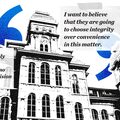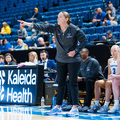Pulitzer winner Emily Nussbaum talks origins of popular TV at Bird Library

Pulitzer Prize-winning critic Emily Nussbaum visited Syracuse University’s Bird Library on Tuesday. She explained the transformation of television and examined the influential role Gertrude Berg played on “The Goldbergs.” Francis Tang | Daily Orange File Photo
Get the latest Syracuse news delivered right to your inbox.
Subscribe to our newsletter here.
UPDATE: This post was updated at 12:42 p.m. on March 21, 2025.
Though she never studied journalism, Pulitzer Prize winner Emily Nussbaum regularly dissects media. She believes television in the early 20th century transformed in many other ways than just its medium. Nussbaum focused on one particular example which showcased this evolution, television pioneer Gertrude Berg, in a Tuesday talk at Syracuse University.
“People in academia or elsewhere didn’t take television very seriously,” Nussbaum said. “But Gertrude Berg was an extremely big deal, nationally known to everyone.”
Nussbaum, a television critic and staff writer at The New Yorker, spoke with SU students at Bird Library on Tuesday afternoon. After recently publishing her book, “Cue the Sun!: The Invention of Reality TV,” Nussbaum shifted her attention to the period before television. She explored the history of Berg’s influence on American culture as the showrunner and star of the show, “The Goldbergs.”
The show initially gained attention in 1929 as a radio broadcast show. After becoming more popular, the show ran through 1945 before transitioning to television a few years later and continuing until 1956. Nussbaum described Berg as the inventor of the family sitcom.
Michael Sullivan, a freshman television, radio and film student at SU who attended the event, said he was baffled by the level of popularity Berg had and how little today’s society knows about her.
“Someone that I’ve never heard of being so influential in TV history seems like something I had to be at,” Sullivan said.
The show portrayed the life of a Jewish mother, Molly Goldberg (played by Berg), and her family. She was described as the “head of the household,” doing everything for the family. Nussbaum cited Jewish inclusion as the most radical aspect of the show, especially during the time period it aired in.
“This was a big breakthrough,” Nussbaum said.“They were portrayed not as an exotic set of people, but as relatable and patriotic.”
Michael Crisci, a freshman broadcast and digital journalism student, said hearing from another perspective was a key part of capturing topics in media. He said the inclusion of different perspectives changed the way people watched TV and its overall evolution.
Nussbaum explained one of the core distinction between movies and books versus radio and TV is the difference in reaction to the audience. Radio and TV was “made in front of you” and was always a rough draft that was guided by the audience, she said. This not only valued the audience, but created a parasocial relationship between viewers, listeners and the show as a whole.
Nussbaum said Berg would often receive letters about the show’s positive impact on viewers’ lives. Though, some letters asked Berg to change aspects of the show or were critical of its representation.
“People felt a sense of intimacy and passion with the show,” Nussbaum said. “They had the feeling that they should be able to guide the show to some extent.”
While the politics of the show separated it from others, it was also the main source of tension during the show’s run. Some sponsors and networks tried to cancel the show because of its content.
After a brief hiatus, Berg pitched the show to CBS as a piece of television, implying she was owed for her success in the ‘40s, Nussbaum said. The TV show was eventually greenlit and was a huge success.

Courtesy of Ariana Zink
Emily Nussbaum came to Syracuse University to discuss the work of Gertrude Berg, a pioneer in radio and television.
On TV, the show still maintained an intimate connection with its audience, with the Goldberg character speaking to the camera and breaking the fourth wall. So much had changed with how the show operated, with previous viewers now seeing a literal, physical depiction of the Goldbergs and their apartment. While the medium changed drastically, Berg still maintained her political tones in each episode.
“It had a huge audience, and this was just as television was about to go big,” Nussbaum said. “The show continued to be soaked with politics.”
In an era where TV was exploding and viewership was at an all time high, the late 1940’s also brought on the Red Scare, which led to many members of Hollywood being blacklisted — including one of the members of “The Goldbergs.”
This created skepticism toward the show as a whole for its radical ideas. Despite opposition from Berg and other members of the show, it was eventually removed from the network and replaced with “I Love Lucy.” Not only did this represent a setback for the ideas the show aimed to promote, but it also influenced how television was adapted in the future.
Nussbaum emphasized how important Berg was in revolutionizing the medium of television, particularly the parasocial relationships that are now rampant on social media. Although Berg was fighting for more radical ideas, the industry moved toward safer, friendlier topics to harness maximum viewership. Berg has since become a lesser-known figure despite her influence on the entertainment industry.
Nussbaum explained her main reason for researching Berg was her initial conception of her. She described her as a cool, heroic and influential figure who had been forgotten and who she wanted to raise up.
Crisci came out of the event with a new idea on what he valued in the media. He noted it’s not just about who’s saying something, but how people absorb it.
“My takeaway was the importance of diverse voices within the media,” Crisci said. “On top of that, the importance of how an audience reacts and its acceptance throughout society.”






